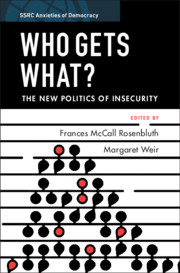Book contents
- Who Gets What?
- SSRC Anxieties of Democracy
- Sponsored by the Social Science Research Council
- Who Gets What?
- Copyright page
- Contents
- Figures
- Tables
- Author Biographies
- Acknowledgments
- 1 Introduction
- Part I People
- Part II Places
- 6 Keeping Your Enemies Close
- 7 America’s Unequal Metropolitan Geography
- 8 Redistribution and the Politics of Spatial Inequality in America
- Part III Politics
- Index
- References
6 - Keeping Your Enemies Close
Electoral Rules and Partisan Polarization
from Part II - Places
Published online by Cambridge University Press: 20 August 2021
- Who Gets What?
- SSRC Anxieties of Democracy
- Sponsored by the Social Science Research Council
- Who Gets What?
- Copyright page
- Contents
- Figures
- Tables
- Author Biographies
- Acknowledgments
- 1 Introduction
- Part I People
- Part II Places
- 6 Keeping Your Enemies Close
- 7 America’s Unequal Metropolitan Geography
- 8 Redistribution and the Politics of Spatial Inequality in America
- Part III Politics
- Index
- References
Summary
This chapter takes issue with the dominant notion that political polarization can be understood as a process through which parties diverge on a single dimension of political conflict. Rather, I introduce the notion that affective political polarization intensifies when new issue dimensions are added. In a two-party system, the parties will appear to be moving further from the average voter, and further from one another, if they offer ever-more heterogeneous and incoherent bundles of platforms over time as new issues are politicized. In the United States, as a result, increasing hostility toward the out-party goes hand in hand with increased ambivalence about the in-party. Meanwhile, the parties become increasingly internally fractious. In a multiparty system, on the other hand, when new issues emerge, parties can position themselves throughout the multidimensional issue space. As a result, voters feel closer not only to their in-party but also to the average out-party. In this way, I suggest that multiparty systems can reduce overall levels of affective polarization.
- Type
- Chapter
- Information
- Who Gets What?The New Politics of Insecurity, pp. 129 - 160Publisher: Cambridge University PressPrint publication year: 2021
References
- 4
- Cited by

